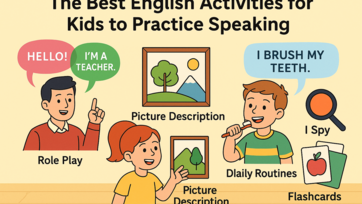Children who are naturally shy often find speaking English, especially in front of others, to be quite intimidating. But with the right encouragement and a nurturing environment, even shy kids can blossom and develop strong communication skills. Here's a full, human-written, AdSense-friendly article (~1,000 words) on effective strategies parents and teachers can use to support shy learners in speaking English confidently.

Understanding Shyness in Children
Shyness is not a flaw—it’s a personality trait. Many shy children prefer observing before engaging in new situations, and they may need more time to feel comfortable voicing their thoughts. The key is creating a safe, patient, and supportive space where they can grow at their own pace Reddit.
1. Start Small with One-on-One Time
Before introducing shy kids to group settings, begin with one-on-one interactions—like short, relaxed English sessions with a parent or teacher. This builds trust and helps them practice without pressure. Gradually increasing familiarity before group work eases anxiety illinoisearlylearning.org.
2. Provide Predictable Structures
Shy children feel more secure when they know what to expect. Use simple visual aids—checklists or weekly routines—with clear, repeated English phrases: "Time to read," "Let's share one word." Predictability reduces stress and encourages participation Edutopia+15marinlibrary.org+15Cambridge Home School Online+15.
3. Praise Effort Publicly, Celebrate Progress Privately
In group settings, shine a spotlight on participation—no matter how small. A statement like “Great job answering one question today!” helps them feel valued. Then, in private, offer gentle recognition: “You did wonderfully. I saw your courage!” This combo builds self-esteem without overwhelming them EdutopiaTandfonline.
4. Create Low-Pressure Speaking Opportunities
Use pair or small-group activities like “hot seat” guessing games or back-to-back drawing. These reduce social pressure compared to whole-class speaking and allow shy kids to engage naturally YouTube+15TEFLHandbook+15Cambridge Home School Online+15.
5. Encourage Peer Modeling
Often, kids learn best from their peers. Encourage warm, outgoing classmates to model speaking and invite shy students gently. Seeing peers engaged and applauded helps shy learners feel more comfortable over time marinlibrary.orgillinoisearlylearning.org.
6. Use Scripted Interactions and Sentence Stems
Provide ready-made phrases like “My favorite animal is…,” or “I think…” to guide students. These “sentence starters” help shy kids join conversations without the stress of formulating everything from scratch Edutopiaillinoisearlylearning.org.
7. Celebrate Mistakes as Learning Moments
Frame errors as normal and valuable. Say things like: “That was brave to try!” or “Great effort, even with a small mistake.” Teaching a “mistake-friendly” mindset boosts confidence and empowerment Edutopiaillinoisearlylearning.org.
8. Integrate Fun Games That Encourage Speech
Games like Taboo, Storytelling chain, or Secret word are playful ways to spark confidence. These activities prompt natural speech in engaging formats where mistakes are easy and laughter is expected Reddit+8Edutopia+8primarytimes.co.uk+8.
9. Create Physical Comfort Zones
Allow shy children to participate from a distance—perhaps seated slightly apart or near an adult until they feel ready. Small adjustments like these reduce anxiety without singling them out illinoisearlylearning.org.
10. Build Emotional Checkpoints
Openly discuss feelings: “How was it to speak up today?” “What felt good—what was tricky?” These gentle check-ins show that you care and help them develop emotional confidence alongside language skills.
Bringing It All Together: A Weekly Plan
-
Monday: One-on-one practice + praise
-
Tuesday: Paired drawing or reading
-
Wednesday: Simple scripted game + group praise
-
Thursday: Peer modeling activity
-
Friday: Fun group game like Taboo or storytelling chain
Consistency builds trust. Over time, these small, repeated successes turn distant observers into active participants.
Why This Works
-
Controlled environments reduce stress
-
Repetition and support build familiarity
-
Games and scripts spark natural speech
-
Positive feedback strengthens confidence
-
Peer modeling shows it’s okay to try
This combination aligns perfectly with strategies recommended by educators to help shy children thrive socially and academically
Final Thoughts
Helping shy children speak English confidently is a gradual journey. With patience and thoughtful strategies, they learn to trust themselves, understand that voices are valued—even small ones—and find comfort in expressing ideas. It’s not about changing who they are, but empowering them to share their voices when they’re ready.
; ?>







